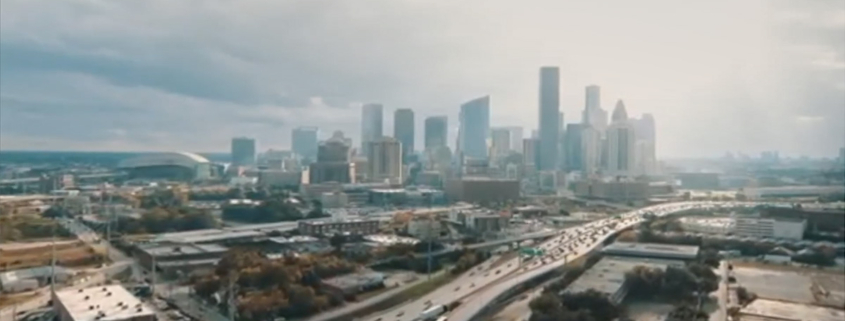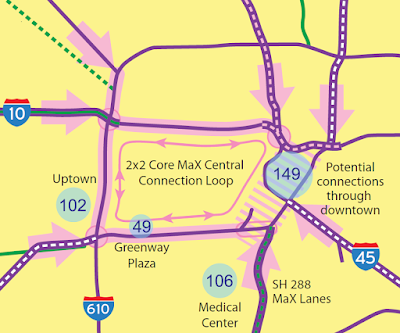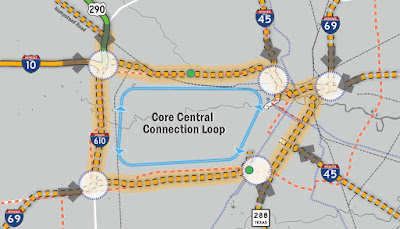Planning Starts for Houston’s Managed Lanes Network, Plus COVID Impact on Metro Ridership
This week we have a great two-part guest post from Oscar Slotboom of Houston Freeways fame, starting with some fantastic news on an interconnected managed lane network for Houston!
Planning Starts for Houston’s Managed Lanes Network
The Houston Chronicle recently reported on initial planning for a comprehensive, interconnected managed lanes network for Houston (print edition pdf). Regular blog readers are aware that Tory and I have been promoting this concept – including the MaX lanes report we released in 2017 (blog post, report: lowres, highres) – which we believe could eventually support one million jobs in Houston’s core job centers.
A key feature of our proposal is the “Core MaX Central Connection Loop“, which is intended to connect all the MaX lanes and enable maximum accessibility to activity centers. Using this loop, anyone coming in on any of Houston’s spoke MaX Lanes will be able to access any of the core job centers (blue circles are job centers with their total number of jobs).
We were pleased to see that the preliminary plan shows a connection loop on the same location which the Houston Chronicle calls the “Box” and a preliminary planning document calls the “Core Central Connection Loop”.
Recent online documents at H-GAC reveal more details about the initial concept.
- The Inner Katy and West Loop segments appear to be the first priority. The IH 69 and downtown segments are not yet conceptualized.
- The Inner Katy segment appears to be targeted to be the system backbone. It is listed as a planned $2.2 billion addition to the 2045 plan. Presumably this cost includes the already-planned Metro BRT. The planning document states “TxDOT wants [this project] to be in the same fiscal year as inner Katy BRT to construct these projects in conjunction with BRT.” The BRT is currently listed to start in 2023 or 2025.
- This H-GAC presentation (starting at page 63) shows preliminary concepts for the West Loop, including potential mobility hubs at Westheimer. The planning document lists the West Loop segment at $553 million in 2026.
This is all very exciting! Let’s hope TxDOT and H-GAC can continue to move the planning process forward and identify the needed funding.
COVID impact on Metro Ridership
COVID-19 has reduced public transit ridership 62% nationally. The plot below show’s Metro ridership for the last year, with overall boardings down 56% between September 2019 and September 2020.(Metro data)
 Park & Ride service has suffered the the most, down 88%. In the depths of the COVID shutdown in April, Park & Ride ridership dropped to 1090 daily trips, a 97% drop, before starting a very modest recovery. Of course, many Park & Ride customers are now working from home, and they have the option to drive to work to reduce their risk of exposure, and reduced traffic makes driving faster than pre-Covid trips. Buses mainly serve transit-dependent populations, and bus ridership shows the smallest percent loss.
Park & Ride service has suffered the the most, down 88%. In the depths of the COVID shutdown in April, Park & Ride ridership dropped to 1090 daily trips, a 97% drop, before starting a very modest recovery. Of course, many Park & Ride customers are now working from home, and they have the option to drive to work to reduce their risk of exposure, and reduced traffic makes driving faster than pre-Covid trips. Buses mainly serve transit-dependent populations, and bus ridership shows the smallest percent loss.Dallas has experienced a ridership drop of 57%, nearly identical to Houston. We probably won’t see a rebound in transit ridership until there is widespread vaccination and rush-hour traffic congestion returns to pre-covid levels.
I could not find recent highway traffic data for Houston, but nationally highway traffic rebounded sharply during the summer and is now mostly reported to be between 90 and 100% of pre-covid levels. (1, 2).
Dallas highway traffic is down 8% in September 2020 compared to September 2019. (ref)
This table summarizes the data for September 2020 versus September 2019.
| Houston bus | -51% |
| Houston light rail | -56% |
| Houston park & ride | -88% |
| Houston Metro overall | -56% |
| Dallas public transit | -57% |
| USA public transit | -62% |
| Dallas highway traffic | -8% |
| DFW Airport passengers | -45% |
This piece first appeared on Houston Strategies Blogspot.
Tory Gattis is a Founding Senior Fellow with the Center for Opportunity Urbanism and co-authored the original study with noted urbanist Joel Kotkin and others, creating a city philosophy around upward social mobility for all citizens as an alternative to the popular smart growth, new urbanism, and creative class movements. He is also an editor of the Houston Strategies blog.








